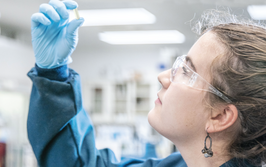
Coming in From the Cold
Lyophilization has changed little over the last 75 years, and the pharmaceutical industry has struggled to address the known inefficiencies of this old technology. Now, a new consortium has been founded to provide a risk-free environment to help advance lyophilization instruments and processes. Is freeze-drying finally heating up?
Lyophilization is an essential pharmaceutical process, but it is considered time-consuming and expensive. The LyoHub consortium, based at Purdue University, Indiana, USA, hopes to change that by advancing the science and technology of freeze-drying. Other members include the University of Connecticut, IMA Life, Pfizer, Janssen, Millrock, Inficon, Baxter, SP Scientific, Allergan, Abbvie, McCrone, Roche, Pfanstiehl, Siemens PLM Software, Fresenius Kabi and Bristol-Myers Squibb. Importantly, LyoHub is not just a talking shop; it has developed a unique demo facility, located in the Birck Nanotechnology Center in Discovery Park, on Purdue University’s campus, where consortium members can test new lyophilization processes in a low-risk environment. LyoHub also aims to be an important information depository about lyophilization processes and training. One of their most recent achievements is the publication of the LyoHub Lyophilization Technology Roadmap (1) – which over 100 experts contributed to. The Roadmap aims to identify advances that are needed in lyophilized products, lyophilization processes and equipment, the regulatory interface, and workforce training and education.
To find out more about how freeze drying is entering the 21st century, we talked with two of LyoHub’s founders, Alina Alexeenko (a professor in the School of Aeronautics and Astronautics at Purdue) and Elizabeth Topp (a professor of Industrial and Physical Pharmacy at Purdue).
How was LyoHub formed?
Elizabeth Topp: Alina and I are an interesting combination. My background is in engineering, so I have an affection for the process side of things, but my current focus is on the product side, particularly the behavior of lyophilized formulations of proteins. But Alina is a process person – she started out as an aerospace engineer with an interest in computational fluid dynamics. She became interested in lyophilization because its high vacuum/low temperature flow regimes are very similar to those seen in rocket propulsion in outer space. We joke between ourselves that lyophilization really is rocket science! When I came to Purdue, we started collaborating and, soon after, Alina proposed developing a consortium to bring together multiple collaborators and achieve more than we could as individuals. Today, Alina and I lead the consortium, but the leadership team also includes Michael Pikal, a professor of pharmaceutics at the University of Connecticut; and Steve Nail, senior research scientist at Baxter Biopharma Solutions.
Is lyophilization yesterday’s technology?
ET: It is yesterday’s technology in the sense that the freeze-drying process has hardly changed since the 1930s. The first large-scale application of biological freeze-drying was in World War II. The American Red Cross in Honolulu was collecting a lot of blood plasma that needed to be stored – so they flew in a freeze-drier from Philadelphia. Early lyophilizers were based on the autoclave, and the fundamental design has not changed since. And it’s an enormously inefficient design: Alina’s calculations show that some production-scale lyophilizers have an energy efficiency of only five percent! It’s an old technology and the field is ripe for process improvements.
Alina Alexeenko: That said, though the process of lyophilization has been used for decades, it is still very relevant to today’s needs. The number of FDA-approved lyophilized drugs has dramatically increased since the mid-2000s, mainly because of the development of fragile biologics, such as antibodies and antibody drug conjugates. So freeze-drying is becoming more important as time goes on. Although the largest end-product market is lyophilized foods, the greatest compound annual growth rate among lyophilized products is for biologics.
I would also add that there is a lack of education and training around lyophilization. Although young scientists may be familiar with batch lyophilization for isolating chemicals, process lyophilizers work quite differently. I think we’re seeing a generational gap appearing, with the older experts moving into retirement without necessarily passing their skills to the younger generation. But lyophilization has expanded from its traditional use in pharma to things like biosimilars, cells, and diagnostic test kits – and the demand for those skills is only set to increase. We need to make sure the younger generation is able to cope. In the 1990s, only around 11 percent of injectable drugs were lyophilized, but now it’s over half.
What holds innovation in the field back?
AA: Pharma companies must work under strict regulatory constraints, which makes the risk of innovation higher. For example, when a drug is approved, its manufacturing process is linked to that approval, which historically has resulted in a disincentive to change the process. An unintended effect of that has been to put a dampener on process innovation. To get things moving, it is important to get people from different industries to work together. We are partnering with people in the food processing sector as well as pharma. The food industry is very different to pharma: “high volume, low value add” as opposed to “low volume, high value add” of the drug industry. Consequently, food sector processes have evolved, and are ahead of pharma processes in some respects. It is a good time to learn from them and make pharma processing better.
How difficult was it to bring different parties together for LyoHub?
AA: The formation of LyoHub involved a great deal of networking and relationship development in the lyophilization community. Part of it happened naturally through collaborations; for example, when Purdue was working with Abbvie, we needed more information about their lyophilizer, so we had to interact with the equipment manufacturer too. Another part came from linking up projects, resulting in discussions of research needs common to equipment manufacturers and pharma companies. Of course, it takes persistence to get competitor companies to openly discuss these things! We had to keep repeating that improving lyophilization doesn’t give a competitive advantage to one company or another – it increases the whole market, improving revenues and profitability for all companies.
ET: We also had to be open-minded and accept that our members’ research needs might not correspond to the areas that we found most interesting as academics. The consortium consistently asked for the development of a set of common best practices for operational and product qualification. It is not the most exciting research topic, but it’s true that standards are lacking in this field. So LyoHub members have been collaborating to produce best practice papers. This will enable them to speak with one voice to the FDA and hence inform regulatory policy.
What other issues need to be addressed?
AA: On the regulatory side, the number one topic for LyoHub members is process instrumentation, particularly for measuring product temperature; for example, the best thermocouples for the lyophilizer environment, optimal thermocouple positioning, and techniques for monitoring the end of primary drying. Another important topic is equipment performance qualification. These issues are common to any lyophilization process, whether for pharmaceuticals or food, large scale production or pilot clinical production.
ET: Lyophilization cycle time is a particular near-term challenge; balancing short cycles with adequate quality can be difficult. Cycle times of several days, together with the capital costs of lyophilizers, cause production bottlenecks, so cycle time reduction could potentially increase production throughput. This is something we are exploring with our members.
If lyophilization is to really join the modern world, we need better sensors. There is interest in continuous process lyophilization, but we need feed-back and feed-forward control, so that the process can run itself based on sensor information. More sophisticated monitoring will also enable us to determine how the lyophilizer conditions vary across a shelf and from vial to vial, and ultimately to design lyophilizers that make the process more uniform. As a rule, the product temperature is not measured during production, only chamber temperature and shelf temperature. Direct measurement of product temperature would allow the cycle to be optimized in real time during each process. Innovations in this area would also help scale-up – because at present lyophilizer performance is not very reproducible between pilot scale and production scale; the production environment is cleaner than the development environment – there are fewer particulates, which impacts lyophilization because particulates help induce ice nucleation. Once you start to understand the complexities, you can begin to better control nucleation in the production environment.
What led to the Lyophilization Technology Roadmap?
AA: Product innovation helps drive process innovation – technology road-mapping and consortium research has resulted in many innovations, including combination products, prefilled syringes, processes compatible with very small fill volumes, and new diagnostic products. It is a very good time to rethink lyophilization and develop new equipment and new processes – not least continuous processing systems.
Our roadmap brought together over 100 different people – from end users, to equipment or instrument manufacturers – to think about what we need to achieve in the next decade to really move lyophilization forward. The project was funded by the US National Institute of Standards and Technology (NIST) and is published on the USA Manufacturing website. It is a living, breathing document, and it will be updated with new information.
ET: The Roadmap is our process for identifying trends and drivers in lyophilization, to forecast key developments over the next 10 years, as well as issues that may change the field of lyophilization. What if it were possible to lyophilize tissues for transplant therapy? What are the implications of the demand for biologics from the developing world? Could we lyophilize cell-based therapies? Cell therapies could be a game changer for pharma, but the process is tricky. Novartis’ new CAR-T is logistically and technically very complicated – where cells are cryopreserved, flown to a manufacturing site, genetically modified, and then flown back to the patient. The whole thing reminds me of well-choreographed ballet, with the cryopreservation steps taking time and requiring specialized equipment to maintain the ultra-low temperatures. Could lyophilization potentially be a faster and cheaper alternative? It is still early days but there is interest from some companies in seeing if lyophilization can replace cryopreservation.
In the biologics field, there are increasing cost pressures on both innovator and biosimilar companies. Improving process efficiency by implementing advanced lyophilization technology will help drive down manufacturing costs. As well as identifying trends and drivers, we have mapped out areas where the consortium should focus its efforts, and projects it should undertake to meet the needs of its members, such as improved analytical methods, new tools for product design, modeling and simulation, better container/closure systems, and new lyophilization processes that can handle cell and gene therapies, and diagnostic agents.
How have industry reacted to the roadmap so far?
AA: With great enthusiasm! The roadmap includes best practices and we have published one of those in AAPS. There is a counter on the AAPS website and we have already passed 2000 downloads, and the lead author of the paper was also invited to the FDA to present the paper – so I think the community has already begun to take notice.
What is LyoHub focusing on now?
AA: We are very focused on our lyophilization demo facility. We see this as a unique “open playground” where different perspectives and capabilities come together to benefit from access to specialized equipment. We hope by next year to see the commercial application of some of the sensor technology that is now being tested in the facility, and to make a start on continuous process lyophilization.
ET: It is very difficult to change a production process once it has been GMP-certified, but a demo facility like ours enables companies to experiment with processes in a risk-free environment. You can’t go drilling holes in a production lyophilizer to insert mass spectrometry sensors for monitoring individual vials, but we can do that in our demo facility. In the near future, I hope we will see direct benefits from this resource, such as the commercial adoption of the temperature sensors that are now being tested in the facility, and generation of data to support best practice documents for the entire community, not just our members.
- LyoHub, “Lyophilization Technology Roadmap” (2017). Available at bit.ly/2zDrx4K. Last accessed: November 7, 2017.

Over the course of my Biomedical Sciences degree it dawned on me that my goal of becoming a scientist didn’t quite mesh with my lack of affinity for lab work. Thinking on my decision to pursue biology rather than English at age 15 – despite an aptitude for the latter – I realized that science writing was a way to combine what I loved with what I was good at.
From there I set out to gather as much freelancing experience as I could, spending 2 years developing scientific content for International Innovation, before completing an MSc in Science Communication. After gaining invaluable experience in supporting the communications efforts of CERN and IN-PART, I joined Texere – where I am focused on producing consistently engaging, cutting-edge and innovative content for our specialist audiences around the world.


















